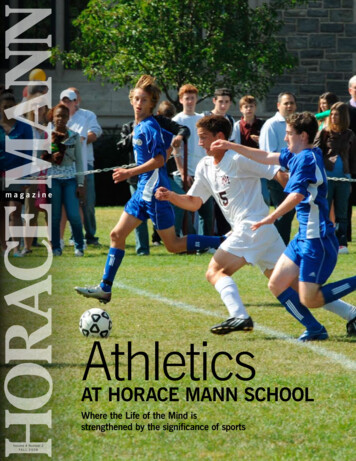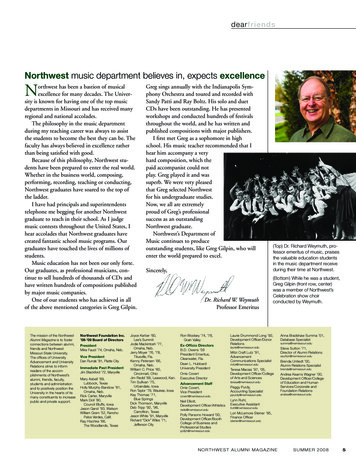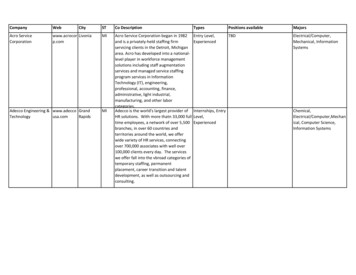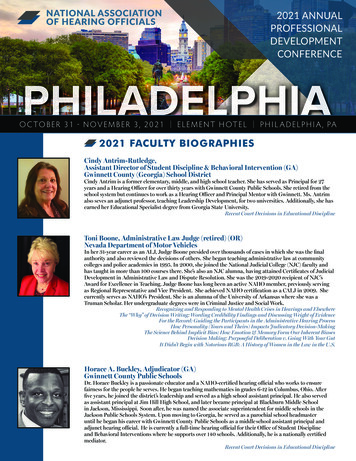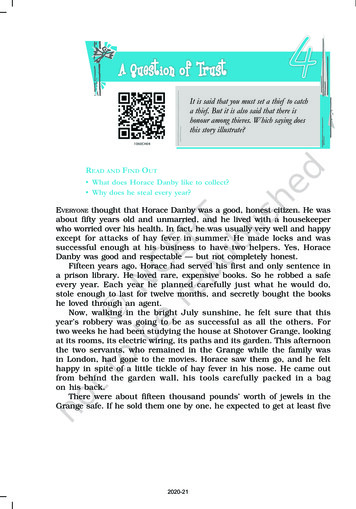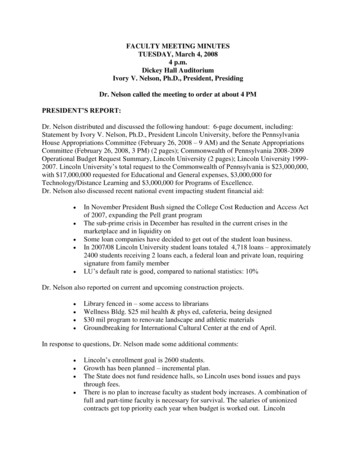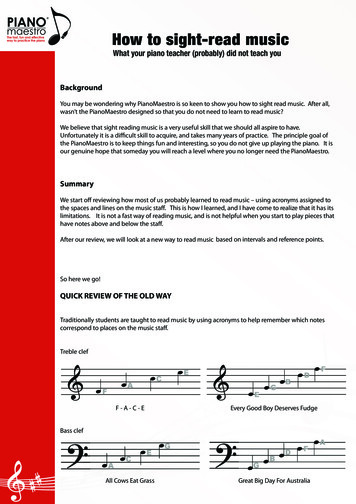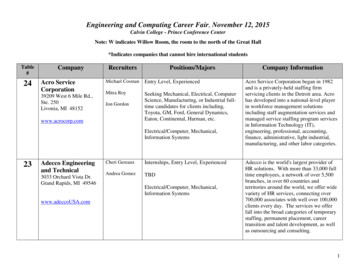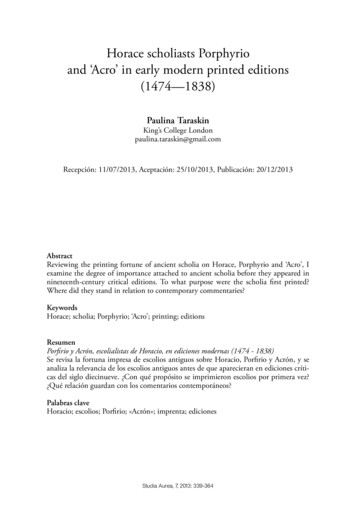
Transcription
Horace scholiasts Porphyrioand ‘Acro’ in early modern printed editions(1474—1838)Paulina TaraskinKing’s College Londonpaulina.taraskin@gmail.comRecepción: 11/07/2013, Aceptación: 25/10/2013, Publicación: 20/12/2013AbstractReviewing the printing fortune of ancient scholia on Horace, Porphyrio and ‘Acro’, Iexamine the degree of importance attached to ancient scholia before they appeared innineteenth-century critical editions. To what purpose were the scholia first printed?Where did they stand in relation to contemporary commentaries?KeywordsHorace; scholia; Porphyrio; ‘Acro’; printing; editionsResumenPorfirio y Acrón, escolialistas de Horacio, en ediciones modernas (1474 - 1838)Se revisa la fortuna impresa de escolios antiguos sobre Horacio, Porfirio y Acrón, y seanaliza la relevancia de los escolios antiguos antes de que aparecieran en ediciones críticas del siglo diecinueve. ¿Con qué propósito se imprimieron escolios por primera vez?¿Qué relación guardan con los comentarios contemporáneos?Palabras claveHoracio; escolios; Porfirio; «Acrón»; imprenta; edicionesStudia Aurea, 7, 2013: 339-364
340Paulina TaraskinCarolingian scholars preserved for us two blocks of late antique Horace scholia:1they revised the late third-century commentary of Pomponius Porphyrio2 andcompiled a heterogeneous body of marginalia, now known as Pseudo-Acro.3 Thelatter body of scholia was detached from the Horace text by the humanists and,circa 1400, received the attribution to the second-century commentator Helenius Acro.4 Renaissance scholars’ enthusiasm for ancient scholia is apparent fromthe 48 fifteenth-century manuscripts of ‘Acro’ and 22 manuscripts of Porphyrio.5Early printers — as we shall presently see — also placed a high value on ‘Acro’ andPorphyrio, but the printing career of these corrupt and fragmentary scholia wasfar from secure.Let us review printed editions of Porphyrio and ‘Acro’, in order to gaugethe importance attached to ancient Horace scholia by their publishers. We shallexamine physical appearance, layout, content of the editions and observe theposition accorded to ancient scholia in relation to contemporary commentaries. Prefatory remarks by the editors and their collaborators should clarify thepurpose of the publications and, sometimes, reveal an interest in the scholiasts’identity or expectations of the scholia genre.This overview is accompanied by a chronological Index of Editions containing ancient scholia.6 In my discussion, I shall refer to the editions by their date,1. This article is a byproduct of the author’sstudy of medieval Horace scholia, ReadingHorace (forthcoming), which contains a surveyof scholarship on Horace scholia copied andcompiled in that period.2. Ancient, medieval, and some RenaissanceTestimonia de Porphyrione are appended toHolder’s edition (1894). Summary descriptions are offered by Borzsák (1998), Schmidt(1997), Nisbet and Hubbard (1970: xlviii—xlix). Recent discussions are provided by Diederich (1999) and Kalinina (2007).3. The two main components of the PseudoAcro compilation were identified and characterised by Noske as fifth-century Expositio Aon lyric and ninth-century Paragraphon scholiaon opera omnia, based on a six-century commentary (1969: 269—76). Interesting pointsare discussed by Nisbet and Hubbard (1970:l—li) and more extensively by Borzsák (1998).4. The misattribution to Acro was notedby Keller, the most recent editor of ‘PseudoAcro’scholia (1903: 311—7; 1904: ix—x). Themanuscript containing the original attributionis described by Noske (1969: xvi—xvii). Acomprehensive recent note is offered by MunkOlsen (2009: 35—6).5. Cf. Villa (1994: 127—34).6. I have so far come across no catalogue ofHorace scholia editions. The Horace volume of the Kristeller Catalogus (1960—) hasyet to appear in print, while his Iter Italicum(1963—) lists only Renaissance manuscripts.An extensive index of publications of Horace’stext with and without commentary is providedby Zeune (1825: 1941—91); a more recent, butless comprehensive and not entirely reliable listis offered by Lenchantin de Gubernatis (1945:liii—vi 1958—1960: xlv—vii). Overviews ofcommented Horace editions, without a specificfocus on ancient scholia, are offered by Niutta(1993), Rocca (1996), and, in greatest detail, byIurilli (1994). All three studies mention ancientcommentaries only in the context of early editions. Iurilli’s enlarged 2004 publication dealsmainly with the Italian reception of Horace, butthe final chapter summarising Horace’s fortunain the 18th century mentions Baxter 1701 andBaxter-Gesner 1752 editions (2004: 78). Thethird volume of the Enciclopedia Oraziana, containing articles on individual scholars, commentators, printers et al., similarly focuses on earlycommented editions; it offers little on Badius,nothing on Bentinus etc.Studia Aurea, 7, 2013
Horace scholiasts Porphyrio and ‘Acro’ in early modern printed editions (1474—1838)341place of publication, and — where appropriate — publisher or editor. The fulland often cumbersomely extensive titles of editions are given in the Index.The date of Horace’s editio princeps is uncertain.7 Ancient scholia form partof the first dated Horace edition, brought out in 1474 by the Milanese publisherAntonio Zarotto (Zarothus) with the financial backing of Marco Roma:8 its firstvolume printed on the 16th of March contains Horace’s complete works, the second volume printed on the 13th of August contains ‘Acro’.9 At about the sametime in Rome, Francesco Marchese (Marchisius) and Angelo Sabino, with thefinancial backing of Giovanni Luigi Toscani, bring out an edition of Horace’s lyricand Ars Poetica,10 where the commentaries of Acro and Porphyrio follow eachpoem. Horace’s opera omnia with both commentaries are produced ca 1481, inVenice or Treviso, by the poet Ludovico Strazzaroli Pontifico (de Strazarolis) andRaffaele Regio, who taught in Padua and Venice.11 Unlike the Roman edition,this one accompanies Horace with Acro alone; Porphyrio, edited by Regio, isplaced separately at the front of the volume. Zarotto emulates this format in hissecond edition of 1485,12 but the 1486 reprint, edited and sponsored by Alessandro Minuziano, brings a change: Porphyrio’s commentary, labelled ‘Porphyrio’ incapitals, follows the (unlabelled) Acronian notes after each poem.13The Roman, Trevisan, and 1486 Milanese editions contain prefatory lettersof dedication, which reveal something of the publishers’ concerns. In the ca 1474Roman edition, Toscani facetiously remarks to his colleague Marchese that theirundertaking will be criticised as adulterous, irreverent, and off-putting for thestudent and that their daring juxtaposition of poetry with commentaries will beridiculed, in Horace’s own words, as adding a human head to a horse’s body.147. The oldest editions listed in the Gesamtkatalog der Wiegendrucke IX (Leipzig 2008) are theVenetian 1471 edition by Basilius (GW 13449)and the Neapolitan 15/11/1474 edition by Arnold von Brüssel (GW 13450).8. Ganda (1980: 111, 125).9. The method of publishing commentary separately from the text was a feature of five earlyServius editions (1470—1475), catalogued byMambelli (1954).10. Bianca (1987: 234) and Iurilli (1994: 582)note that the popularity of lyric is a post-Petrarch fashion, when lyric also becomes the subjectof contemporary commentary. For the popularity of the Ars Poetica in the 15th century see FriisJensen (1995: 229—230).11. The place of printing in unknown. Catalogues, including the Indice generale degli incunaboli delle biblioteche d’Italia III (Rome 1954)and Gesamtkatalog der Wiegendrucke IX (Leipzig2008), identify Venice as the likely location. Tre-viso, home town of de Strazarolis ‘Travisanus’,and Padua, from where Regio addresses his dedication to Venetian noble Morosini, have beensuggested as alternatives.12. Zarotto apparently borrows the titulus forthe newly added Porphyrio from the 1481 Venice/Treviso edition.13. Minuziano draws attention to this layout inhis dedication to Bartolomeo Calco (1486, Milan): «ita expositores in poetae marginibus collocavi, ut facile cognitu sit omnibus, quid Acroquid eruditus Porphyrio super eodem sentiant.»14. Toscani to Marchese (1474, Rome):« e runt qui inventum hoc nostrum lenociniireum dicant, Heli, quod Odis et Epodis ac poesiAcronem et Porphirionem commisceri curaverit, quasi et in figuratis nominibus adulterio locusrelinquatur. nec deerunt qui arguant hanc rerum mixturam operi relligionem ac maiestatemdetrahere, doctrinam salem ac candorem Flacciinducta circum scriptione deturpare, legendiStudia Aurea, 7, 2013
342Paulina TaraskinIn the same edition, Marchese complains about the corrupt state of the textand the need to rely on a single Acro exemplar.15 Marchese’s publication of lyricand the Ars is mentioned as «Romae nuper impressa duntaxat demidiata» inthe 1481 edition, where Regio urges the reader to compare it with the superiorquality of his own new text. However, Regio’s collaborator Strazzaroli calls hisbluff: in the dedication of the Horace-cum-Acro part of the same volume he laments that the three Acro manuscripts available to him are far from satisfactory:de Acrone autem, cuius tria habebamus volumina, nullum fere verbum, ne dicamsententiam, aderat in uno quod idem in aliis aut adesset aut non depravatum siaderat legeretur : perinde ac si non unum sed diversos exponerent Horatios.The situation with Porphyrio’s text is much the same. In words to be echoedby many after him, Regio praises Porphyrio to the skies and bewails the poorstate of the commentary, hoping that his own efforts at emendation may provesatisfactory.16 The 1486 reprint of Zarotto’s 1485 (second) edition is promptedby the discovery of a new exemplar. In the dedication to Bartolomeo Calco,Alexander Minuziano regrets the corrupt state of the former unique exemplarand boasts of his new find: itaque hos libros studiosissime quantum sub unico exemplari, eoque temporuminiuria exeso librariorumque incuria mendosissimo, recognovimus. caeterum impressis libris et recognitione iam publicata, venit ad manus meas Porphyrio quidamantiquissimus It is notable that ancient scholia, whatever the quality of their text, wereconsidered a worthwhile investment for the printer.avidum tironem si quasi delibaverit litteras nenon sine interprete Oratii mentem percipereposse videatur a legendo avertere, atque telamartificis omnem disrumpere. separatim hec imprimi utilius et commodius fuisse, magisque addignitatem singulos collaturos quam coniunctos, iustius quoque quod suum est unicuiquevolenti reddi debuisse quam in communionemredigi incitos: nihil aliud hoc esse quam humano capiti cervicem iungere equinam.» Iurillipoints out the novelty of combining two commentaries (1994: 582).15. Marchese to Toscani (ca 1474, Rome):«.sed hoc mihi molestum fuit, quod in hisHoratii libris qui te maxime hortante impressisunt, non eam quam vehementer optassememendationis exhibere diligentiam potui, atcerte quantum in me fuit et curam omnem etstudium adhibui, sed Acronis exemplaria utscis defuere: unum habuimus nec id quidemsatis emendatum.» I thank Carlotta Dionisotti for observing that this exemplar of Acromay well be Zarotto’s edition.16. Regio to Morosini about Porphyrio (1481,Venice/Treviso): «huius tam egregii litteratorisquem ego vel priscis omnibus grammaticis anteferrem dum censuerim lucubrationes in Horatium sive librariorum negligentia sive temporisiniquitate pene amiseramus. tot enim in his extabant inversa, transposita, manca, errata ut nonmodo non intellegi sed ne legi quidem multis inlocis possent. In Pophyrionis vero enarrationibus castigandis id quod potuimus †per quam†sollicita usi sumus diligentia quae quidem siimpressorum non violabitur negligentia haudquaquam dubito quin nostrae emendationismunus tibi discretissimisque fratribus Andreaeatque Marco maxime cordi futurum sit.»Studia Aurea, 7, 2013
Horace scholiasts Porphyrio and ‘Acro’ in early modern printed editions (1474—1838)343The fifteenth century saw the appearance of several new commentaries: onthe Ars by Tommaso Schifaldo and Martino Filetico, on lyric by Antonio Calcillo (Chalcidius).17 Calcillo had lectured on Horatian lyric in Rome in 14651466. The commentary arising from Filetico’s ca 1470-1471 course on the Arsmay be dedicated to none other than Toscani.18 Yet the early printing of Horace,notes Iurilli (2004: 24), does not seem to be connected with contemporaryscholastic activity.The first Renaissance commentary to appear in print is that of the Florentine professor Cristoforo Landino, printed by Antonio Miscomini in Florencein 1482.19 Landino — unlike most contemporaries — not only covers Horace’sentire opus but claims to rival the ancient scholia.20 This popular commentaryhad its critics. Minuziano, in the 1486 Zarothus reprint, acidly remarks, inwords much quoted by modern scholars, that it is his duty to remedy the damage inflicted by a certain recent commentary.21 Landino’s commentary was neverprinted in Milan,22 but before the century was out it had featured in at leastnine editions published elsewhere. In Venice (1490/1), Giovanni Francesco Superchio (Philomusus) combined Landino with the ancients, surrounding smallsections of centre-page Horace text with copious Acro, Porphyrio, and Landino(in that order), punctuated by marginal ‘lemmata’ and pointers.A year later, Antonio Mancinelli added a second modern commentary (onlyric) to the three printed so far. Mancinelli’s 1492 edition was repeatedly reprinted and fathered a long line of Venetian publications of Horace ‘cum quattuor commentariis’,23 to which further contemporary commentaries, notes, metrical explanations and vitae were prefixed and appended. The layout of Mancinelli’s edition differs from Superchio’s in one subtle detail: Mancinelli placeshis own exegesis first, followed by Acro, Porphyrio and Landino. The place ofAcro’s vita and expositio metrica is taken by Ode quid per Ant. Mancinellum andHoratii Venusini Vita per Ant. Mancinellum edita.17. Villa names several more Renaissancecommentators: Giovanni Cuffarino, Franciscus Buti of Pisa, Andrea Volsco dub. (1994:134 seq.). It is clear from the same catalogue,that at least one medieval commentary, the12th-century French Materia commentary published by Friis-Jensen (1990), continued to becopied: it is found in six, presumably Italian,15th-century manuscripts. See also Friis-Jensen(1995).18. Bianca (1996, esp. 276).19. Landino had already produced a commentary on the Aeneid in 1478.20. Cf. Cardini (1974: 249).21. Minuziano to Calco (1486, Milan) : « cum vererer, ne si id penitus detrectassem, pluri-mum de majestate Oratiana nobis tolleretur, obtemerarium et veluti sacrilegum cuiusdam conatum, qui recentissimas in Flaccum interpretationes edidit. de quibus verissime dici potestid quod de Rupilio rege noster inquit Oratius‘pus atque venenum’ tam sensuum quam verborum huius eminentissimi vatis — id quod nisiPorphyrionis antidotis repressum fuisset, brevitotus contabuisset Oratius.»22. For subsequent critics, including UgolinoVerino, Badius, Celio Rodigino, see Bausi’s‘Landino’ article in the Enciclopedia OrazianaIII (Rome 1998: 307—9).23. The 1543 Venetian edition ‘cum quinquecommentariis’ contains three modern commentaries.Studia Aurea, 7, 2013
344Paulina TaraskinThe first non-Italian scholar to engage in commenting on Horace was the Flemish humanist Josse Bade van A(s)sche (Jodocus Badius Ascensius).24 Badius’ SilvaeMorales anthology, published in 1492 in Lyon, contained excerpts from Horace andother authors, accompanied by his own commentary.25 At the turn of the century,Badius published the whole of the Satires and Epistles with Acro’s and his own commentaries (1499/1500, Lyon). In 1516 Badius’ lyric commentary appeared in Giovanni Britannico’s Venetian edition (printed by Alexander Paganini) together withPorphyrio, Mancinelli, and Britannico’s hexameter commentary. Badius’ own complete commented Horace, printed in Paris by Petit in 1519, replicates the Venetian‘cum quattuor commentariis’ pattern. Following the Venetian example, here Badiusreplaces the gothic typeface of his Lyonese Horace with Roman type.In 1533 the Parisian printer Robert Estienne (Stephanus) brought out anotherVenetian-style publication, Bernardino Martirano’s edition of the Ars Poetica. Acroand Porphyrio are flanked by commentaries by Martirano’s Calabrian compatriotGiovan Paolo Parisio (Aulus Janus Parrhasius), deceased 1522, and the Swiss poetscholar and musician Heinrich Loriti (Glareanus).26 After one reprint of this separate edition of the Ars Poetica (1536, Paris), Glareanus and Parrhasius joined a longlist of commentators in the enlarged 1544 Venetian edition of opera omnia.27The popularity of Horace editions with multiple ancient and modern commentaries is obvious from the prolific number of reprints through the sixteenth century.28It is clear from the appearance of the books, that they are designed for a scholasticmarket: the complete Horace volumes are of folio size (excepting the 1506 hexameters and 1533 Ars Poetica) and their margins are filled with copious commentarynotes. Contemporary commentaries forming the bulk of these books are designedfor teaching. They aim to give a much more systematic and detailed explanation ofthe text than is offered by ancient scholia; their level is fairly elementary. Mancinellimakes his purpose explicit in the dedicatory epistle to Pomponius Laetus:hinc illud fateri audeo in Odis ipsis et in Epodis Carmi n eque Saeculari per meenucleatis (prius autem a tribus aliis Acrone Porphyrione Landino haud satis) nihilpene deesse ad rerum aut sensus cognitionem.24. At this time, the German scholar JakobLocher (Philomusus) returned to Strasbourgfrom his Italian travels and produced, in 1498,the first major German publication of Horace’sworks equipped with his own commentary. Unlike Badius, Locher did not (to my knowledge)publish any ancient scholia.25. 1492, Lyon (J. Trechsel) Silvae Morales cuminterpraetatione Ascensii: In XII libellos divisae.A detailed catalogue of Badius’ editions is provided by Renouard (1908).26. Parisio’s commentary was published sepa-rately by Martirano in 1531 (Naples, J. Sultzbach); Glareanus’ edition of Horace, accompanied by his own notes and Niccolo Perotti’smetrical treatise, was printed in 1533 (Freiburg,J. Faber Emmeus).27. Martirano’s edition was reprinted oncemore almost a century later (1621, Lyon).28. I have traced seven Venetian and two Milanese reprints of Mancinelli’s 1492 edition, fourof Britannico’s 1516 Venetian, three of Badius’1519 Parisian editions, and eleven of the 1544Venetian opera omnia.Studia Aurea, 7, 2013
Horace scholiasts Porphyrio and ‘Acro’ in early modern printed editions (1474—1838)345Similarly, Badius prefaces his commentary (1503) with an exhortation tostudents («Adhortatus sum vos, adolescentes optimi, sepe numero antehac.»).In the dedication of his Ars Poetica commentary, Glareanus disparages the youthof his day and sees his mission in educating: «ut iuventus utilissimis imbutainitiis frugem aliquando ferret uberem». It is revealing that, although ancientscholia were not considered sufficient on their own, they nonetheless continuedto occupy a firm position in the teaching context, alongside modern exegesis.The ancient commentaries gradually gain prominence over their modernneighbours. In the preface to his 1499/1500 Lyon edition of Horatian hexameters, Badius describes his own commentary as a humble scholastic auxiliary,29but Acro — as a prize for the experienced reader:non etenim aliud nobis propositum fuit quam verborum ordinem non sine faciliexplanatione contexere; ne tamen doctioribus maturae desint fruges, Acronis viriargutissimi commentarium praeposuimus.In his 1519 Paris edition, Badius puts Acro and Porphyrio first in the titulus; in the text itself they appear ahead of both Badius and Mancinelli, alteringthe order of Mancinelli’s own 1492 edition.30 The Venetian editions of Badiusexamined by me (1536, 1545, 1546) retain the traditional order, whereby Acroand Porphyrio are sandwiched between modern commentators, but from 1543Venetian tituli replicate the Parisian ones, headed by Acro and Porphyrio.The apex of ancient commentators’ prominence among the moderns is theBasel editions printed by Heinrich Petri (Henricpetri) in 1545 and 1555. A thirdcommented edition was issued in 1580, the year following Henricpetri’s death,by his son Sebastian. Like the Paris and Venice publications, these folio volumesare produced for teaching,31 but Petri revises the presentation of both commentary and text. In the 1545 edition, a wide column of Horace is accompanied29. The method and purpose of Badius’ 1500commentary on the Ars Poetica — namely offering his reader access to a variety of relevant material in digested form — is discussed by Weinberg(1955).30. In Badius’ 1506 edition of the Epistles, hisown commentary, marked ‘Ascen’ in the margin,likewise follows Acro.31. The 1545 Basel edition recommends Horace for the teaching of both morality and Latinity: «Qui igitur volent teneros puerorum animosita formare, ut iis gaudeant, quibus oportet ,quique volent studiosorum ingenia pura elegantique eruditione et lingua excolere, hunc poetampueris tradant assidue versandum.» The senti-ment is echoed by the 1580 edition, extollingHorace among other classical authors as teacherof both morality and eloquence. The titulus ofthe 1580 edition advertises its usefulness for bothscholars and teachers: «Vt igitur omnes studiosilegere, iunioribusque interpretari sine remorapossint.» The 1555 editor, Georg Goldschmidt(Fabricius), not only considers Horace a particularly suitable school-room author («lectioneinprimis dignum et adolescentibus explicandumsemper iudicavi»), but commemorates the building of a new school in his dedication («quod bonarum artium studiis honorem habetis eximium,id quod nuper pulchris aedificijs, in extruendo afundamentis ludo novo, declarastis»).Studia Aurea, 7, 2013
346Paulina Taraskinby a narrow italic column of commentary,32 which spills into full page after thepoem. Acro and Porphyrio are praised in the titulus (« Acronis et Porphyrionisoptimorum, sine controuersia, autorum »), and their scholia are placed before aselection of contemporary commentators, varying from poem to poem.33The two-volume 1555 Petri Horace, edited by Georg Goldschmidt (Fabricius), is particularly remarkable. In the first volume, Acro and Porphyrio aloneaccompany Horace’s text;34 contemporary commentaries are relegated to thesecond volume, with the exception of the Freiburg professor Johan Hartung,who precedes Horace in volume I. Like others before him, Fabricius attempts toimprove the text of scholia with the help of manuscripts. He approaches scholiaon a par with ancient authors:cum autem interpretum Horatianorum libri corruptiores fuerint quam ullius adhucLatini scriptoris monumenta fuisse compererim, multis saepe locis, et in Italia et inGermania, codices manuscriptos inquisivi.An annotated codex sent by George, Prince of Anhalt-Dessau, enabledFabricius to produce a much improved Acro.35 Less fortunate with Porphyriomanuscripts,36 Fabricius notes which elements appear to be lacking from hiscommentary:desideratur enim narratio Porphyrionis de vita Horatii, cuius ipse mentionem adSermones facit libri primi, Satura sexta: desiderantur graeca epigrammata, quae abeodem commentatore aliquoties adducuntur, et plurima fortasse alia.Here Fabricius calls to witness Porphyrio’s commentary itself (ad Sat.1.6.41). We shall presently see him exploit grammatical texts as evidence for theidentity of the scholiasts.The third Basel Horace, produced by Petri’s son in 1580, was edited byNicolaus Hoeniger.37 This single-volume edition endeavours to represent a32. Italic fonts were used for the commentariesby Estienne is his 1533 edition of the Ars Poetica.33. Additional modern material agglomeratedat the front and back of ‘cum quattuor commentariis’ editions is here incorporated into the bodyof the commentary after the relevant poem.34. Acro and Porphyrio take pride of placeeven in the index (1555, Basel): «.in Acroniset Po r phyrionis tum aliorum authorum commentaria.»35. Fabricius (1555, Basel): «.accesserunt adOdarum commentationes non pauca, ad Artempoeticam multa, ad Sermones plurima sedhoc minime vanum aut superbum est, me huiuslibri integritatem, copiamque secutum, multoquasi habitiorem, et nitidiorem in palaestramliterariam producere Acronem Helenium.»36. Fabricius (1555, Basel): «in Porphirione expaucis membranis antiquis, emendavi tantumaliqua, addidi pauca, dissipata, ut spero, colligiomnia. In Epistolis nihil a codice antiquo auxilijfuit, id quod expetebam maxime, propter disputationes et διαλογισμως, verbis subobscuros »37. The Short-title catalogue of books printedin the German-speaking countries I (London1962, 416) names Fabricius (deceased 1571) asthe editor of the 1580 publication. The 1580volume includes Fabricius’ 1555 dedicationamong other old prefaces, but it is not clear tome what contribution — if any — Fabriciusmade to this new edition before his death.Studia Aurea, 7, 2013
Horace scholiasts Porphyrio and ‘Acro’ in early modern printed editions (1474—1838)347greater number of commentators than the two previous Petri publications, theancient scholiasts retaining pride of place. Eulogising Henricpetri in his preface,Hoeniger mentions still more ardent admirers of ancient scholia, who wouldhave ancient annotations alone as a sufficient tool for interpreting Horace.38One such champion of ancient scholia is a slightly earlier Basel editor of Horace, Michael Bentinus. I have postponed the discussion of his 1527 edition, whichstands out among its contemporaries. In contrast to the folio ‘text-book’ editions,this octavo volume contains the text of Horace and a single commentary of Acroplaced at the back, much in the style of today. Unlike ‘cum quattuor commentariis’editions, this presentation did not take on and, to my knowledge, was never reprinted. (Bentinus died of the plague in the autumn of 1527.) Fashion notwithstanding, Bentinus considered Acro’s commentary a useful and self-sufficient toolfor the study of Horace. In his dedication to Konrad Heresbach (Herzbachius),tutor to the dukes of Cleves, Bentinus explains why he singled out Acro:Porro interpres et si non vetustissimum, utpote Prisciani et Servii, quem semel autiterum citat aetate posterior, certe omnium iudicio inter Horatianos interpretesfacile primum sibi locum vindicat. Nam Porphyrionis bonam partem desideramus.C. Aemilium, Modestum, Gelenium et caeteros, de nomine tantum novimus, quorum si extarent commentarij, facile paterer recentiores, si ita videretur, obsolescere.Verum cum hic unus ab interitu vix servatus sit, indignus sane visus est, qui contemptu et typographorum incuria totus periret.There are two interesting points. Firstly, Bentinus is dissatisfied with whatis available of Porphyrio.39 Secondly, he mentions two new names among thescholiasts: Aemilius and Gelenius. The source of his information is ‘Q. HoratiiFlacci vita ex vetusto quodam exemplari descripta’ placed before the Horace textand ending with the words «.commentati sunt illum Porphyrion, Modestus,Gelenius, Acron, omnium optime C. Aemelius.» The same brief vita printed inthe earliest editions by Regius (1481) and Zarothus (1485) ends with the morefamiliar list: «.commentati in illum sunt Porphyrion Modestus Helenus[,] etAcron omnibus melius.» Bentinus obtained his vita from a codex lent him byJohannes Sichardus.40 This codex Sichardi vita is cited by Schweikert (1865: 3,38. Nicolaus Hoeniger to Huldrich Coccio (?)(1580, Basel): « Henricus Petri iamdudumcomplectens aliquot virorum doctorum in huncpoetam lucubrationes expressit, applausu commodoque studiosiorum haud vulgari: diversotamen quorumdam iudicio, nam Acronis et Porphyrionis commentarios, ut nonnulli caeteris omnibus anteferebant, sic quoque ad mentem poetaenostri et ad sententias explicandas sufficere omninocontendebant.»39. Fabricius (1555, Basel) recalls Bentinus’dissatisfaction: «Priscos autem in hunc poetamcommentarios eiusmodi iniuria et calamitas sinon attigisset, ut ad Heresbachium aliquandoscripsit Bentinus, facile pateremur recentioresquosdam interpretes obsolescere.»40. The author regrets not having timely accessto Lehmann’s (1895) study of Sichardus’ work.Bentinus to Heresbach (1527, Basel): «Proindecuravimus, ut et nitidior, et emendatior tuonomini condictus in lucem prodiret. Autorisvitam ex antiquo codice, cuius copiam nobisStudia Aurea, 7, 2013
348Paulina Taraskinnote 9): «commentati sunt illum Porphyrion, Modestus, I. Gelenius, Acron omnium optime Acron.» Schweikert points out that ‘omnium optime C. Aemelius’arose from a collation of Sichardus’ ‘omnium optime Acron’ and the standard‘Acron omnibus melius’.41The error perseveres in the subsequent Basel editions up to and includingHoeniger’s (1580). In Fabricius’ 1555 edition, ‘C. Aemelius’, together with Julius Modestus and Terentius Scaurus, receives an acknowledgement in the titulus to volume I: «admixtis interdum C. Æmilii. Julii Modesti et Terentii Scauriannotatiunculis». In his preface, Fabricius lists the ancient scholiasts, stating, intrue scholarly fashion, the source of his knowledge about each.42 In most cases,the evidence consists of a citation or a mention by the grammarians, but thename of Aemelius is known to him from a fragment used in the earlier Baseledition, that is by Bentinus.43 While stating clearly that the writings of ‘Aemelius’, Modestus and Scaurus are lost, Fabricius expresses the hope that some portion of their material might survive — within ‘Acro’. Over-optimistic thoughthis suggestion may be, Fabricius’ open-minded observations about ‘Acro’ arevaluable. He suggests Acro as a possible repository for older material, because itoften combines several explanations of the same point.44The co
King's College London paulina.taraskin@gmail.com Recepción: 11/07/2013, Aceptación: 25/10/2013, Publicación: 20/12/2013 Abstract Reviewing the printing fortune of ancient scholia on Horace, Porphyrio and 'Acro', I examine the degree of importance attached to ancient scholia before they appeared in nineteenth-century critical editions.

